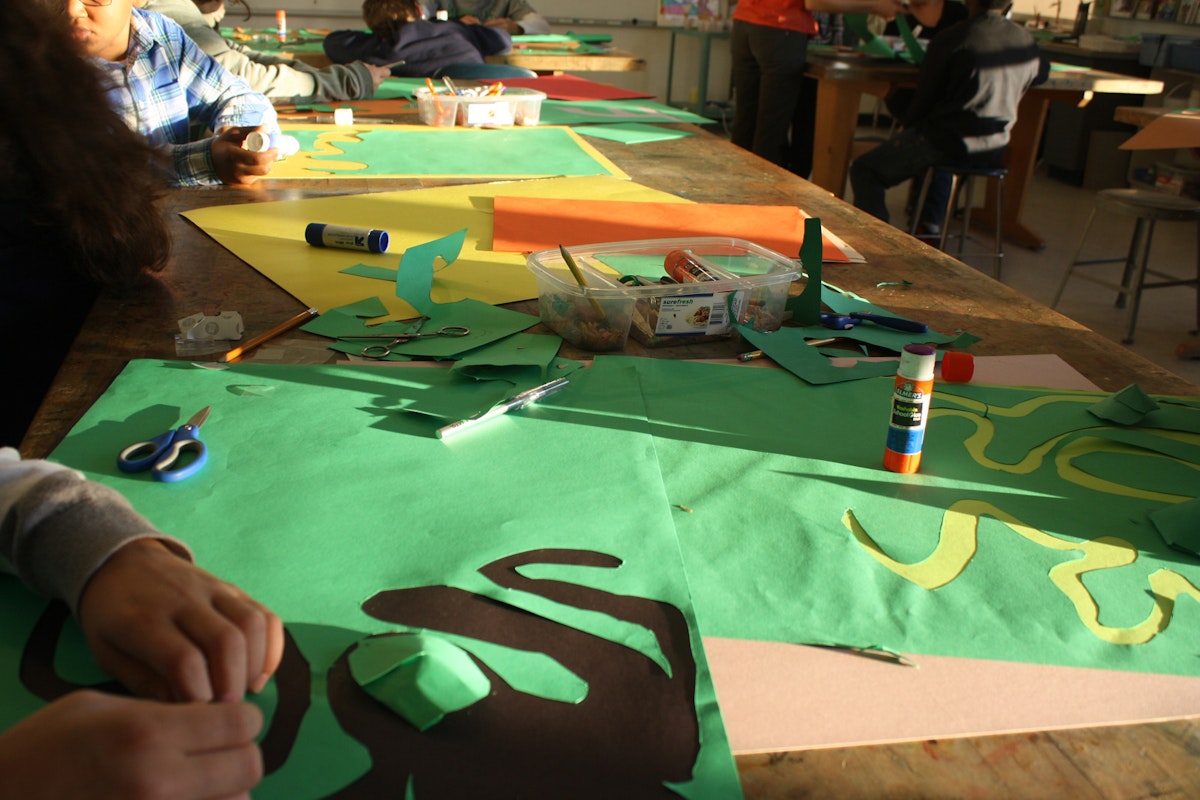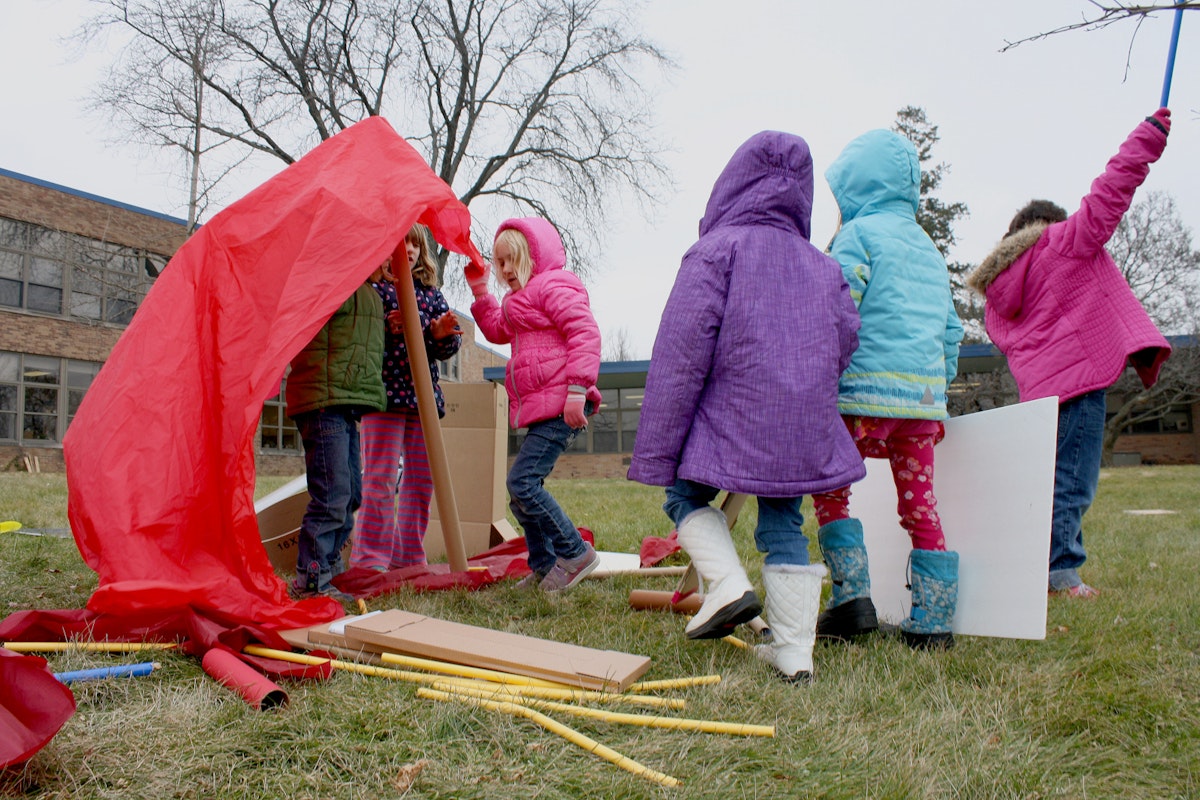Laura Amtower: The Wild Idea of a Child-Designed Playground
Laura Amtower’s MFA thesis project lies at the nexus of child-centered design, participatory research and curriculum development. Working with students at Ann Arbor S.T.E.A.M. School and their art and design teacher Rachael Van Dyke, Laura recently spearheaded a major, year-long student-led design project: the redesign of the school’s playground.

How did you get connected with Ann Arbor S.T.E.A.M. @ Northside Elementary?
I met with Rachael Van Dyke, the art and design teacher at Ann Arbor S.T.E.A.M.(STEAM) in September just to chat about art education in general. I majored in art education in undergrad and it continues to be part of my creative practice now as an MFA student. During our meeting she explained that the school had recently converted from Northside Elementary to A2 STEAM @ Northside, and was undergoing a facility expansion. The plan for a new gymnasium would either eliminate the kindergarten & 1st grade playground or replace it with a typical boxed slide and swing set.
Serendipitously, we both had a vision of a “what-if” scenario – a new child-designed playground that became part of the curriculum at the school. She was kind enough, or crazy enough, to let me jump on board with this idea and to share her classroom throughout the 2014-2015 school year.
How did you approach this big project in this classroom and with the school?
S.T.E.A.M. stands for Science, Technology, Engineering, Arts and Mathematics. STEAM schools are amazing because they are project-based learning schools, where concepts and ideas are taught through hands-on projects. The playground redesign was a natural fit. It encompassed so many aspects of their education: engineering, math, physics, sociology, and design, to name a few.
We began slowly by incorporating concepts students were learning in their home classrooms into play-based art activities. For example, fifth grade students were learning about kinesthetic energy. We tapped into the idea of stored and potential energy by creating running paths down the hill in their schoolyard. Students created designs and then voted on one that we actually spraypainted on the grass.
The children then had the opportunity to run the path and discuss the experiential components of their designs. The more projects and concepts we taught around the idea of the “playground,” the more buzz it created in the school's community. By November we had developed a whole portfolio of playground-related lessons and projects to begin showing the principal and contractors that we were serious about implementing a child-designed playscape.

What kind of design ideas and concepts have the students come up with?
There is a big range! The projects can be broken down into categories though: Ziplines, Obstacle Courses, Mazes, Landscaping (trees, gardens, tall grass, etc.), Pathways (for running, walking and aesthetics), Slides, Swings, Mounds & Tunnels, Climbing Structures (the MOST universally-important category), Interactive Stations (musical gardens, marble shoots, loose parts, and really anything they could come up with), Shelters, and Grassy Areas for Sports.
Many categories overlapped from grade to grade but some differed. Grades 4 & 5 seemed to be more concerned with designing spaces for organized sports while grades 2 & 3 cared more about small shelters for imaginative play.
You’ve been spending a lot of time at the school. How has your role developed there?
I’d say I’m like a visiting artist and educator. I began at Northside in September by simply showing up and helping Rachael because I wanted the experience of working with her and in a project-based school. I signed the book every day and wore a visitor tag on my collar. After a few weeks, we decided to make my role more official and I began collaborating with Rachael on curriculum design for first and fourth grade, while also helping out with third, second and fifth grade classes. Now I can't walk through the hall without students yelling “MS. AMTOWER! You're here today!”
This is a really big project. What is the timeline and what will your show be like?
This is a thesis project operating in real world time. Due to the elementary school’s timeline and the climate of Michigan winters, the playground won't actually be built until summer. But I’ll be working with them till the end to ensure a smooth implementation. For my MFA show in March, I will be pausing at this midway point of the project and packaging the curriculum and process to share in the gallery. I’m calling the show Connecting Curriculum and it will let viewers observe the entire project arc, including curriculum design, community involvement, and students’ developmental process and designs.

What do you feel that you, as an artist, are bringing to this project and curriculum design?
I think being an artist allows you a certain license to try things out. Artists bring more flexibility in methodology. Our ideas and process can be more open-ended. I can expand the scaffolding of their curriculum with creative projects. Artists understand that projects are a process, sometimes a long process. It is also in my nature as an artist to share things visually, which kids really respond to.
This project involves a lot of people and variables. What surprises have you encountered along the way?
I entered this project without any idea if it could actually happen. I knew I could write a pedagogy, I trusted child-centered designs, and I believed there was a need for serious intervention in public education. I'm still in awe at the receptiveness and support from parents, teachers, community and even contractors to collaborate on such a wild idea as a child-designed playground.
The most surprising factor has truly been the level of engagement from the students. They have been working on this one big concept for an entire year, and I have yet to hear one complaint. Really! Because they know this project will directly impact their lives, they are taking it very seriously. They really understand that what they are doing in our classroom lessons is research and they are excited to contribute. They want their voices heard. And I’ve been surprised to hear the students constantly address the notion of risk. They want more risk-taking on their playgrounds and in the classroom.

How did the stamps MFA program facilitate this kind of project?
I entered Stamps with an undergraduate dual degree in Art Education & Studio Art. I've always been drawn to the methodologies and structures in education, and the go-getter innovation employed in the arts. However I had not found success in merging the two until I started graduate school at Stamps. At Stamps I began working with Nick Tobier and Charlie Michaels in Detroit Connections: Change by Design. With them I helped facilitate the exchange of social enterprise among undergraduates and high school students in Detroit’s Brightmoor neighborhood to design projects with positive impact among both the school and surrounding community. I continued to work as a Detroit Connections Graduate Student Instructor (GSI) throughout the spring in a different class, Active Classroom, to initiate classroom collaboration among U-M undergraduates and fourth graders in Southwest Detroit. Apprenticing under Nick as a GSI provided new perspectives on reciprocating knowledge through creative and seemingly unconventional ways.
Now, I’m in my third year, and my advisors Janie Paul, Nick Tobier, and Stephanie Rowden have each advocated for my continued participation in their engagement courses -- not only for an extra hand on deck, but because of my experience in the classroom. Working alongside these Stamps faculty members to facilitate such successful projects, in addition to my Engaged Pedagogy Initiative fellowship, has opened new doors to considering what's achievable through combining creativity with pedagogy.
My Stamps mentors fostered my wildly growing interest in developing engaged pedagogies that enabled both collaboration and real-world application. They offered support during and outside the university calendar semester and, while I developed and ran two of my own programs the summer before thesis, they demonstrated genuine interest and were always available for conversation. Really, I can't begin to describe my gratitude for this.
For more information and photo documentation of Laura's child-designed playscape, visit her website.
Laura's thesis work will be on exhibit at Work: Ann Arbor from March 13 - April 4th. For more information, visit the 2015 MFA Thesis Exhibition page.